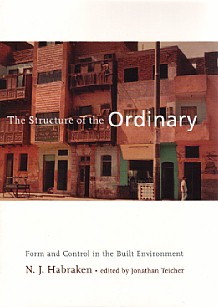|
 . .
The Structure of the Ordinary , Form and Control in the Built Environment
Jonathan Teicher, Editor
© 1998 N.J.Habraken
MIT Press, Cambridge and London, 1998 ./ Hardcover ISBN 0-262-58195-7/ Paperback edition, 2000, ISBN 0-262-08260-8 / Korean translation 2000, ISBN 89-7086-366-4 93540 /
Click here to buy this book at Amazon. For Europe also Bol.com.
__________________________________________________________________________________________ _______________
"Our subject, then, is not architecture, but built environment. It is innately familiar. Anew, we observe what always has been with us - not to discover, much less to invent, but to recognize."(from the books Prologue)
___________________________
quotations from some reviews....
___________________________
"The Structure of the Ordinary" summarizes my observations of, and theories about, the built environment as a self organizing entity.
It reflects my long term conviction that we must try and understand the workings of the built environment to improve, from the knowledge thus gained, our attempts to enhance it.
To understand something as complex as our built environment we must seek what is common in its many manifestations and constant in its transformations. As with all studies of physical phenomena, patterns of change reveal the laws it is subject to. At the same time, change is caused by our interventions. Therefore, by learning to see environment in terms of change, we also learn to understand the ways in which we organize ourselves as agents acting upon it.
We come to distinguish three 'orders':
In The Order of Form it is observed how we operate on different 'levels' of the built environment. This hierarchy may differ somewhat from time to time or place to place, but always has the same characteristics.
In The Order of Place we look at control of space, it brings to light territorial hierarchies different from those found in physical form. The two - the formal and the territorial hierarchies - mutually influence and interpret one another.
The Order of Understanding, finally, comes about because those who intervene always do so, inevitably, in a context of meaning and social understanding. The largely unspoken conventions we adhere to are revealed in patterns, types, systems, and other regularities that can be seen in environment in endless variety.
****
to bibliography overview...to short list...to theory list....to Korean list......to comprehensive list
|